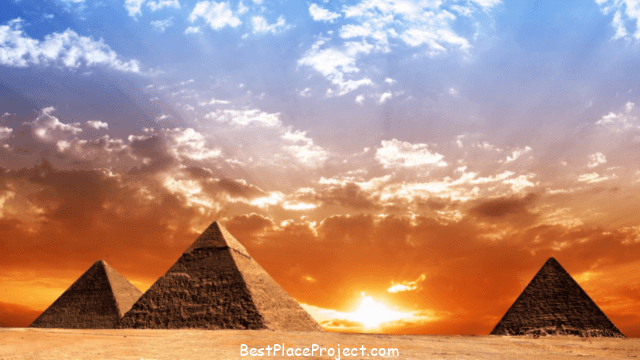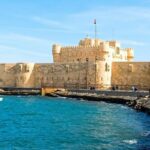Egypt, the former home of the Pharaohs, is a tourist attraction with spectacular temples and tombs that astound everyone who travels there. However, it’s not all historical monuments and tourism destinations.
There are several activities in Egypt for all kinds of tourists, including 4WD excursions over huge desert expanses, diving at world-class coral reefs and shipwrecks in the Red Sea, and boating the renowned Nile River.
While archaeological enthusiasts will have a field day in Luxor, beachgoers travel to the Sinai or the Red Sea Coast to soak up the sun.
For those who prefer the fast pace of the city, Cairo is the unbeatable megalopolis, while Siwa oasis and the southern town of Aswan provide a taste of the slower pace of the countryside.
With so much to see and do, Egypt gives tourists the possibility to plan trips that mix culture, adventure, and relaxation all in one trip.
Plan your sightseeing with our list of Egypt’s finest landmarks and places to go.
21. Pyramids of Giza
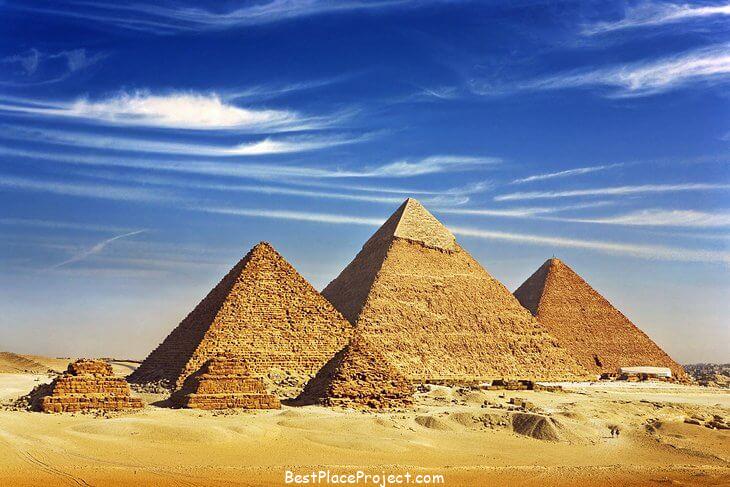
The last surviving wonder of the Seven Wonders of the Ancient World, the Pyramids of Giza are one of the world’s most recognizable landmarks.
Having awed travelers down through the ages, these tombs of the Pharaohs Cheops (Khufu), Chephren (Khafre), and Mycerinus (Menkaure), guarded by the enigmatic Sphinx, are usually top of most visitor’s lists of tourist attractions to see in Egypt and often the first sight they head to after landing.
Today, sitting on the desert edge of Cairo’s sprawl, these megalithic memorials to dead pharaohs are still as wondrous a sight as they ever were and an undeniable highlight of any Egypt trip.
20. Luxor’s Temples & Tombs
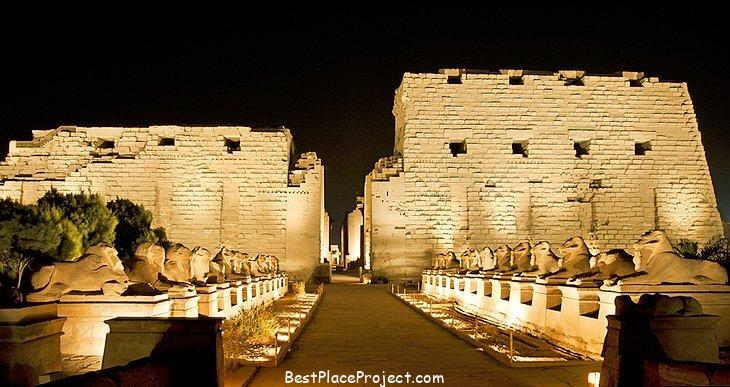
The Upper Egyptian town of Luxor features a tonne of tourist attractions, including the Valley of the Kings, Karnak Temple, and Memorial Temple of Hatshepsut.
Ancient Thebes, the seat of the New Kingdom pharaohs, is home to more attractions than the majority of people can see in a single trip.
The present city, with its bustling souq, the two temples of Karnak and Luxor, as well as the museum, are all located on the east bank of Luxor. The majority of Luxor’s tourist attractions are located on the west bank, which boasts so many tombs and temples that it has been dubbed the largest open-air museum in the world.
You’ll understand why Luxor continues to captivate historians and archaeologists after spending a few days here examining the vibrant tomb wall paintings and marvelling at the enormous columns in the temples.
19. Cruising the Nile
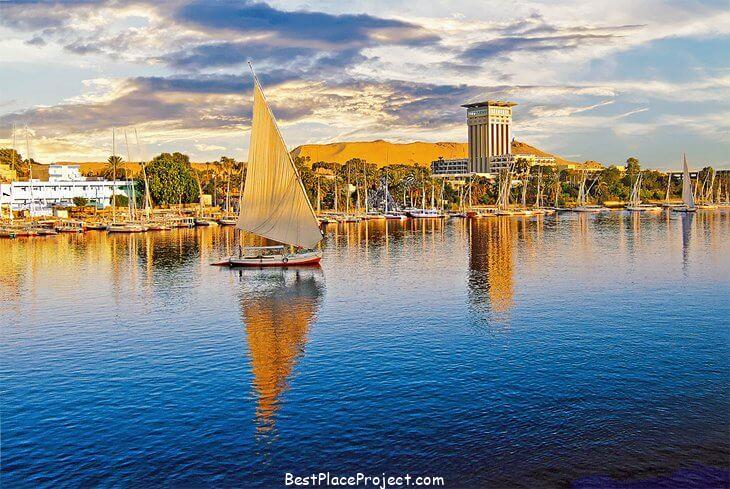
The Nile is what defines Egypt. A multi-day voyage down this renowned waterway, which witnessed the beginning of the Pharaonic era, is a popular tourist activity in Egypt.
One of Egypt’s most serene sights is sunrise and sunset over the date-palm-lined river banks, which are backed by sand dunes. The Nile is also the most soothing way to see the temples that dot the banks of the river on the path between Luxor and Aswan.
The Temple of Kom Ombo and Edfu’s Temple of Horus, where all the big cruise boats stop, are the two most well-known attractions on a Nile cruise.
However, if you want a slower-paced, less crowded experience and don’t mind a little bit of “roughing it,” you can also cruise the Nile on a felucca, one of Egypt’s ancient lateen-sailed wooden boats, which also lets you design your own schedule.
However, feluccas can only be rented for multi-day trips from Aswan, where the majority of cruise ship itineraries leave from.
18. Aswan

Aswan, located among the Nile’s sweeping curves, is the most calm town in all of Egypt. This is the ideal area to stop, unwind for a few days, and take in the laid-back environment because it is surrounded by orange-hued dunes.
Take the river ferry to Elephantine Island and explore the Nubian settlements’ vibrant alleys. Then take a camel to St. Simeon’s Desert Monastery on Aswan’s East Bank. After that, unwind in a riverboat café while observing the feluccas with lateen sails cruising by.
Make sure you take a felucca at dusk to cruise the islands of Aswan. The most popular and tranquil way to see the attractions in Aswan is without a doubt this.
There are many historical monuments nearby and several temples, including Philae Temple on its island, but one of the most well-liked things to do in Aswan is to unwind and observe river life.
17. Abu Simbel
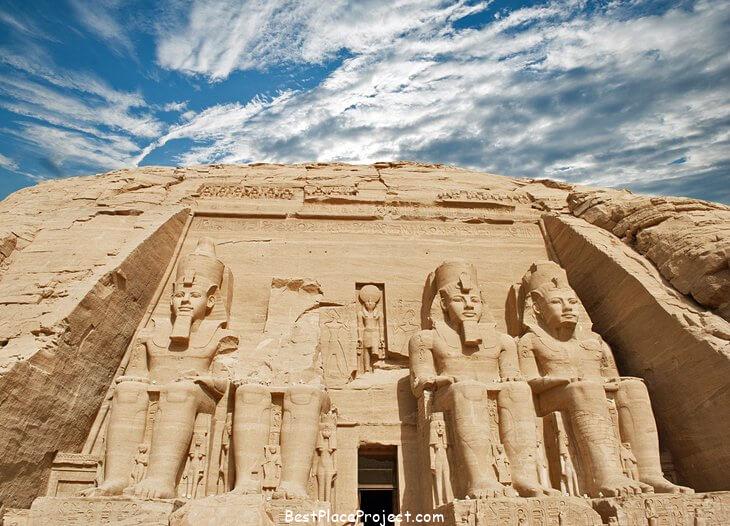
Even though the country is covered in temples, Abu Simbel is unique. This is Ramses II’s huge temple, which is guarded by enormous statues outside and lavishly decorated within with wall murals.
In addition to being renowned for its enormous size, Abu Simbel is also well-known for the amazing engineering feat performed there by UNESCO in the 1960s, which saw the relocation of the entire temple from its original location in order to prevent it from being submerged by the Aswan dam’s rising waters.
Nowadays, visiting Abu Simbel is as much about celebrating the success of the global campaign to preserve the temple complex as it is about staring in awe at Ramses II’s magnificent construction efforts.
16. Diving the Red Sea
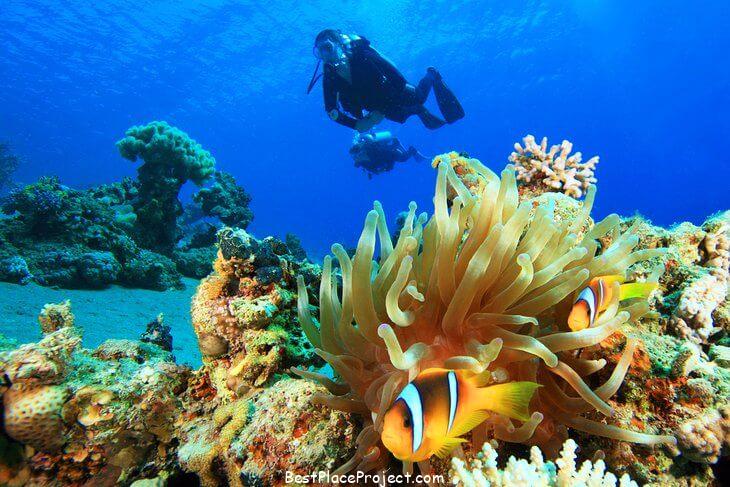
As interesting as the temples and tombs on land is another realm that lies beneath the Red Sea.
The Red Sea’s coral reefs are well-known among scuba divers for their soft coral displays as well as their abundance of marine life, which includes everything from vibrant reef fish and nudibranchs to sharks, dolphins, turtles, rays, and even dugongs.
Sharm el-Sheikh, located on the Sinai Peninsula and closest to the reefs of Ras Mohammed National Park and the Straits of Tiran, is the most well-known town to base oneself in for divers.
Go to Hurghada or El Gouna on the Red Sea coast to dive the Straits of Gubal dive sites. For advanced divers, Marsa Alam is the closest base for exploring Egypt’s “deep south” dive sites.
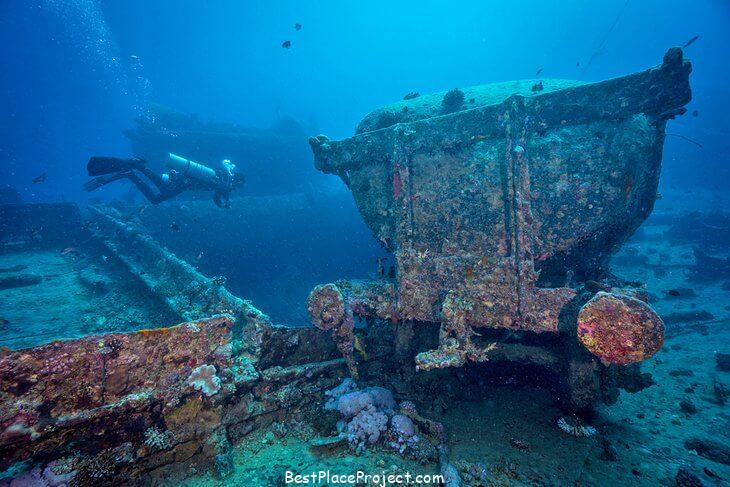
The Red Sea is a popular location for wreck diving in addition to having fish and coral. The Thistlegorm, a British WWII cargo ship that was being used to resupply Allied forces when it was bombed by the Germans in 1941, is the most well-known wreck.
Due to the massive load of vehicles, motorcycles, and WWII memorabilia that can be seen both within the ship and scattered on the seabed around the wreck, the site is now rated by divers as one of the top five wreck dives in the world.
Both Sharm el-Sheikh and Hurghada organise dive boat tours to the wreck.
15. Explore Islamic Cairo
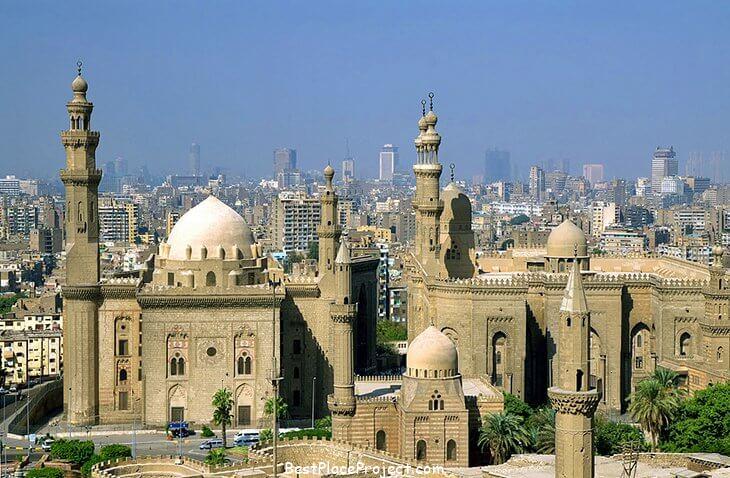
Mosques, madrassas (Islamic schools of learning), and other landmarks from the Fatimid to the Mameluke eras are jammed into the evocative, winding lanes of the capital’s Islamic Cairo area.
This is where you’ll discover the maze-like Khan el-Khalili souq, a market where coppersmiths and other artisans still maintain little workshops and where booths are piled high with pottery, fabrics, spices, and perfume.
A tangle of roads that surrounds the market is home to some of the most exquisitely preserved Islamic structures.
There is a plethora of history to discover in this place. Visit Al-Azhar Mosque and the magnificent Sultan Hassan Mosque, and be sure to climb to the roof of the venerable mediaeval gate of Bab Zuweila for the best views of the neighbourhood dotted with minarets.
14. South Sinai’s Beach Life

On the Sinai Peninsula, in Egypt’s South Sinai region, there is a beach for every kind of vacationer.
A resort town in the style of Europe, Sharm el-Sheikh is crammed with five-star hotels, foreign eateries, and a tonne of entertainment options. Many of the resorts in this area cater to families for one- or two-week sun and sand getaways, making it a favourite among Europeans travelling in the winter months.
Dahab is a laid-back beach town with a backpacker’s heart that values the desert as much as it does the sea. It is famous for its inexpensive dive packages and for the lagoon beach area where windsurfing and kitesurfing are the most popular sports.
The bamboo hut retreats up the coast, between the border town of Taba and the port town of Nuweiba, provide total get-away-from-it-all respites from life and back-to-basics beach living.
13. Saqqara
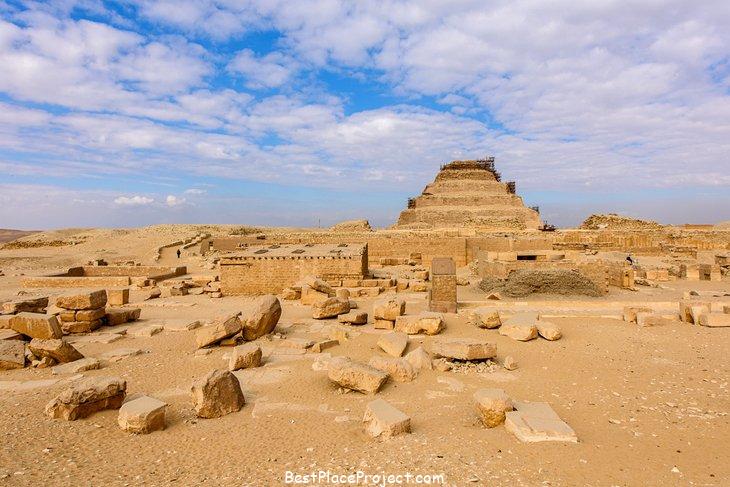
The Giza Pyramids are well-known, but Egypt also has other pyramids up its sleeve. Saqqara, a large necropolis of tombs and pyramids that was used during each period of pharaonic power, is a day journey from Cairo.
Its Old Kingdom Step Pyramid, which demonstrates how Ancient Egyptian architects expanded their engineering expertise to finally produce a genuine pyramid shape, is its most famous feature.
However, there is much more to see than just the Step Pyramid, as some of the nearby tombs, like the Mastaba of Ti, feature some of the best tomb art you will ever see.
The Red Pyramid and the Bent Pyramid are located in the nearby Dahshur pyramid site, and both should be visited while at Saqqara.
12. Egyptian Museum
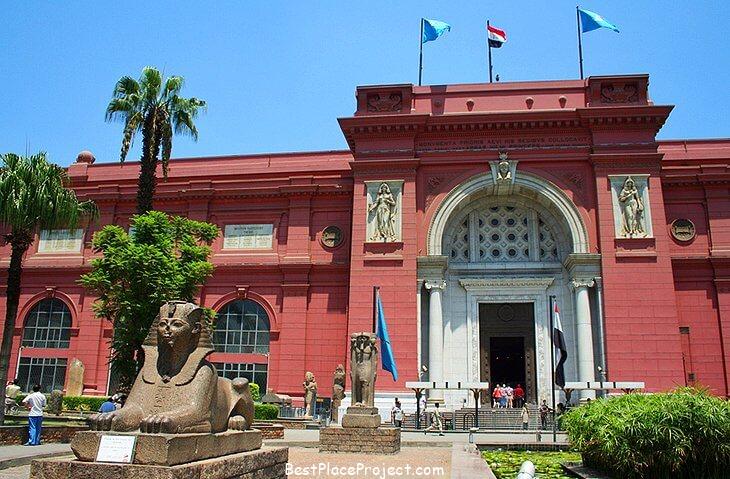
One of the greatest museum collections in the world, Cairo’s Egyptian Museum is a treasure trove of the Pharaonic civilization. There are a bewildering number of exhibits housed in the dilapidated pink palace in central Cairo.
It’s a disorganised space with scant labelling and a serious lack of chronological order. An amazing piece of antique art or statues may be found around every corner here, which would be the focus of any museum.
The haul of golden artefacts recovered from Tutankhamen’s tomb in the Valley of the Kings is the centrepiece of the museum.
Travelers should be aware that the wealth of the Egyptian Museum is currently being transferred to the brand-new Grand Egyptian Museum (GEM), which will be located in Giza, close to the pyramids, and is provisionally scheduled to open in November 2022 (after years of delays).
The entirety of Tutankhamen’s treasures, many of which have been kept in storage for years, will finally be fully on display, thanks to the GEM’s provision of this world-class collection with a deserving exhibit.
11. White Desert

White Desert National Park, located south of Bahariya Oasis in the Western Desert, is Egypt’s quirkiest natural wonder. Here, bizarrely sculpted chalk pinnacles and enormous boulders tower over the desert plateau, giving the impression that icebergs have become stranded in the middle of a sandy environment.
This incredibly beautiful area, which resembles something from a science fiction film, is a favoured location for 4WD desert excursions and overnight camping since Bahariya Oasis makes it simple to arrange both activities.
Anyone who has had their fill of temples and tombs will appreciate this breathtaking natural environment, while desert enthusiasts and adventurers will find it to be the ultimate odd playground.
10. Alexandria
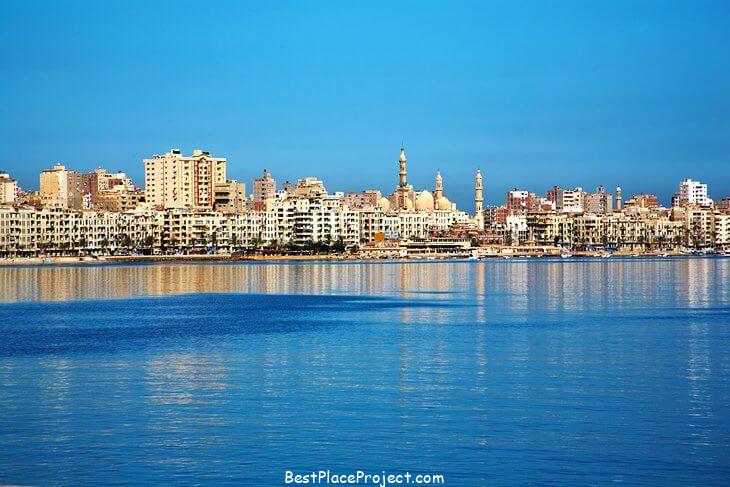
There aren’t many places that can compare to Alexandria’s history.
This seaside city, which was founded by Alexander the Great, was also the birthplace of Cleopatra and a razzmatazz renegade city of the Mediterranean for long of its existence.
Alexandria’s long Corniche seafront road leading to its fort (located on the site where its famous ancient lighthouse once sat) continues to be a popular summer destination for Egyptians and foreign visitors alike to capture cooling sea breezes despite the fact that there are currently few historical remnants of its illustrious past left to see.
Here, underwater archaeological projects have added fascinating artefacts to Alexandria’s museums. The great ancient library of Alexandria has been modernised as the Bibliotheca Alexandrina, and among the town’s few historical sites is the eerie catacombs site.
9. Abydos Temple
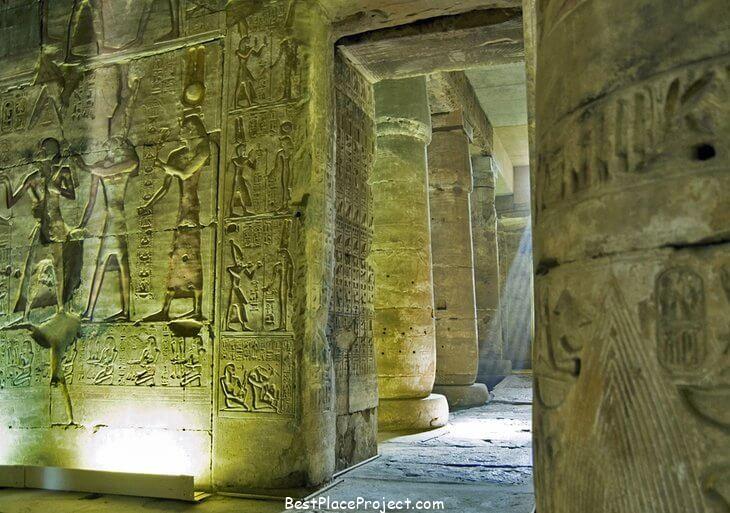
One of the most intriguing aesthetic artefacts from ancient Egypt is the Temple of Osiris in Abydos.
The Seti I-built temple is located within a sizable necropolis where active archaeological investigations are taking place. Although there are many more temple ruins to explore in this area, the Temple of Osiris is the main draw for most tourists.
Some of the best relief work in Egypt may be seen in its hypostyle halls, which are decorated with papyrus-headed columns and have figures depicting the pharaoh and the gods of ancient Egypt.
The temple is far less visited than the temple sites at Luxor and the Nile-side temples to the south because it is located north of Luxor and off the usual cruise ship route. As a result, you frequently have the opportunity to explore the temple’s hallways alone or with just a few other people.
8. Siwa Oasis

Siwa is the peaceful antidote to the bustle of Egypt’s cities, sitting alone in the westernmost corner of the Western Desert. One of the most stunning locations in the Western Desert is this lovely tiny oasis, which is flanked by date palm farms and several hot springs.
Siwa village is built around the ruins of the Fortress of Shali, a massive mud-brick fortification that dominates the landscape. Throughout the larger oasis area are scattered temple ruins, including the Temple of the Oracle, where Alexander the Great is reputed to have sought guidance.
This is a great place to unwind and take it easy for a few days, and it also makes a great base for organising excursions into the nearby desert.
7. St. Catherine’s Monastery
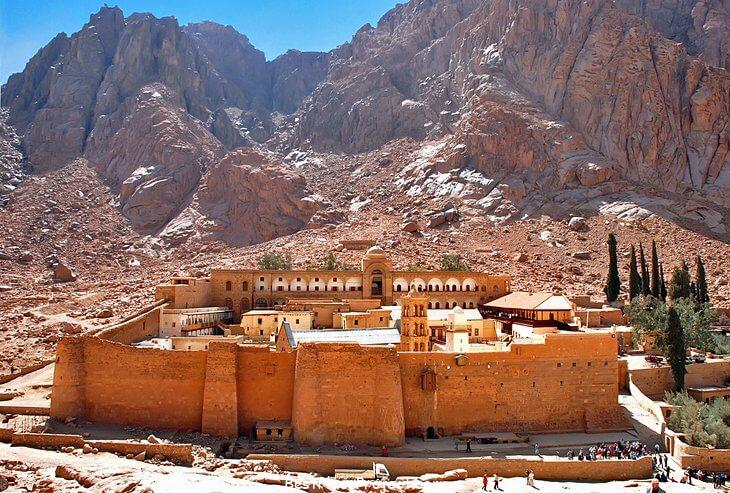
St. Catherine’s, one of the world’s oldest monasteries, is located in the Sinai Peninsula’s desert mountains, close to Mount Sinai, where it is believed that Moses received the Ten Commandments.
In addition to the flaming bush, this desert monastery is home to an amazing collection of religious iconography, artwork, and manuscripts (some of which can be seen in the on-site museum).
The majority of tourists in this area combine a visit to St. Catherine’s with a trek up Mount Sinai to catch the dawn or sunset. If you want an easy way, follow the camel trail; if you want better views, ascend the renowned Steps of Repentance.
6. Red Sea Beaches
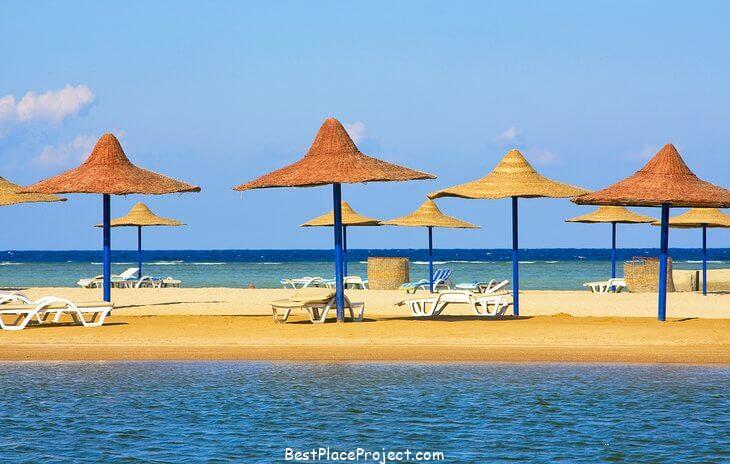
For tourists who need a break from viewing temples, Egypt’s Red Sea coastline offers expanses of sand.
As European families go to Hurghada in the winter for package vacations, the resorts strewn along the shore come to life.
Being able to visit Luxor in a single day makes choosing a resort on the Red Sea coast over one on the Sinai Peninsula an excellent choice if you want to enjoy some beach time while still being close to some of Egypt’s most iconic landmarks.
The two main resort cities are Hurghada and El Gouna, with Marsa Alam being much farther south and being a tiny, newly created city.
5. Coptic Cairo
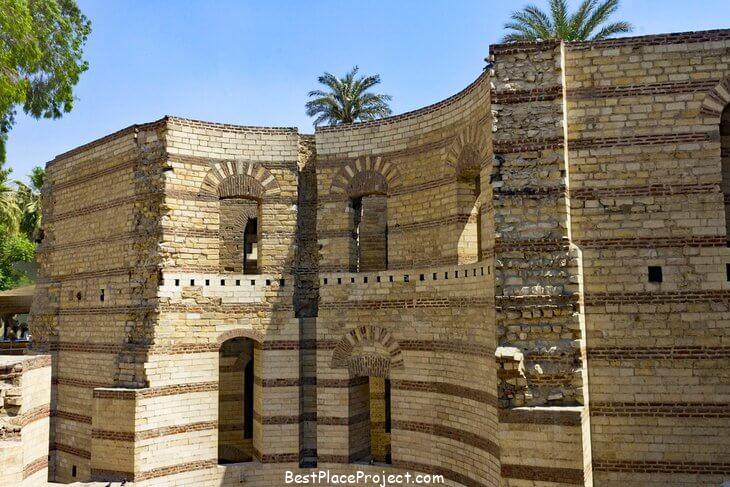
One of the most significant Christian landmarks in the nation is the area of Cairo known as Coptic Cairo.
This area, which was formerly the Fortress of Babylon and dates to the conquest of Egypt by the Achaemenid Empire in 525 BCE, is home to Cairo’s oldest surviving church, synagogue, and mosque in addition to the excellent Coptic Museum, which houses the largest collection of Coptic Christian art and antiquities in the entire world.
The district’s entrance is located on a portion of the Fortress of Babylon’s walls, which were expanded and renovated during the Roman era.
Visit the Hanging Church, which has a beautiful collection of icons and was constructed partially above a water wheel from the Roman era (thus the church’s name). The Holy Family with the infant Jesus resided here in refuge after fleeing King Herod, according to local legend, before making their way down the small alley to the Church of St. Sergius and Bacchus.
The Ben Ezra Synagogue nearby is well-known for being the location where the Geniza document cache was found.
The Amr Ibn Al As Mosque, which was constructed by the Arab Muslim army commander (and subsequently the first governor of Egypt) after conquering Egypt, is just a short stroll away.
4. Wadi Al-Hitan
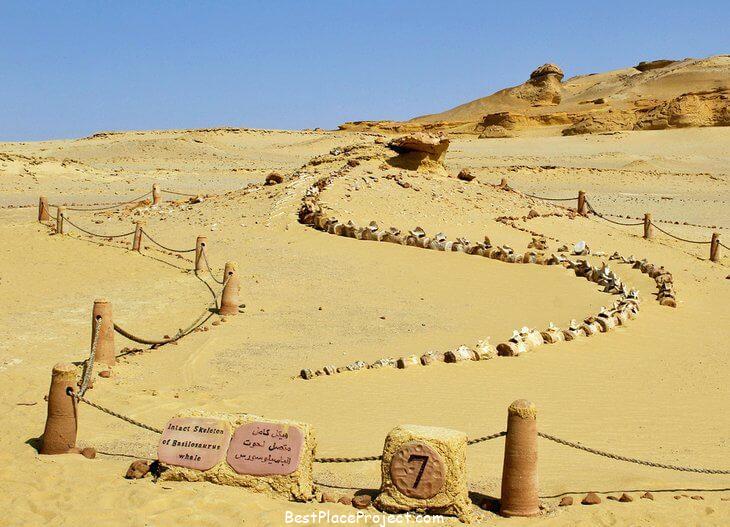
In the Fayoum region, a beautiful and fertile depression fed by antiquated canals and surrounded by desert, is Wadi Al-Hitan.
Although the Fayoum itself is a fascinating spot to explore, with Lake Quran, Tunis, a pottery village, and scattered Pharaonic monuments across the hinterland, the major draw here is the UNESCO World Heritage site of Wadi Al-Hitan in the surrounding desert.
The discovery of a gigantic fossil hoard of the basilosaurus and dorodontus, two of the earliest prehistoric whales, among the valley’s orange dunes and rough rocks greatly aided human understanding of whale evolution.
Walking paths leading from the tourist centre out to skeletal sites buried in the sand are some of the finds that have been left in their original locations.
Wadi Al-importance Hitan’s is well explained in the museum located in the visitor centre, which also showcases many of the other discoveries made there, including an 18-meter-long basilosaurus whale skeleton.
3. Temple of Hathor

Although Dendara itself was a significant religious centre from the beginning of Ancient Egypt, the Temple of Hathor at Dendara was constructed in the late Pharaonic era and expanded throughout the Roman era.
Due to the temple’s young (in compared to other Pharaonic temples), it is one of the most complete remaining temples in Egypt, making a journey here well worth a day trip from Luxor.
Here, the reliefs and decorations are beautifully preserved. The columns topped with the heads of the Egyptian goddess Hathor and the wall reliefs of the Roman Emperor Tiberius paying homage to the Egyptian gods should be particularly noted when in the hypostyle hall, which was constructed by Tiberius.
Dendara is located 80 kilometres north of Luxor, just outside the city of Qena.
2. Monastery of St. Anthony
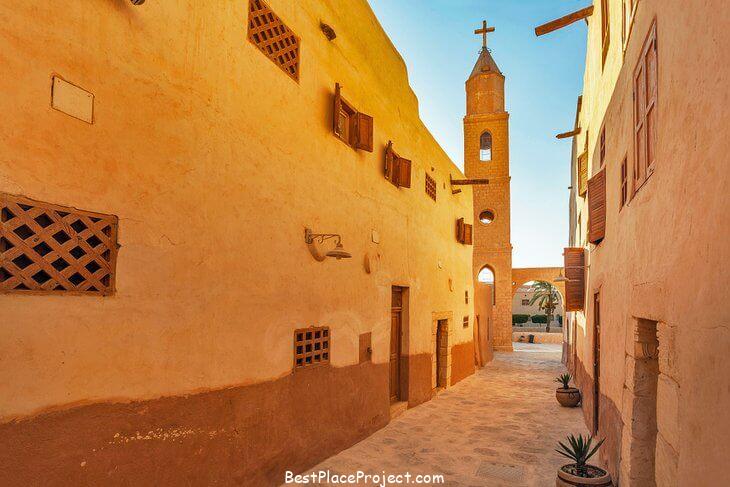
The Monastery of St. Anthony has been a functioning monastery since the fourth century and is continuously inhabited by about 120 monks today. It is hidden within the rough northern mountains of the Red Sea coast.
Within the fortress-like compound, the Church of St. Anthony includes secco wall paintings that date from the 11th and 12th centuries and are regarded as one of the most significant collections of Egyptian Coptic art in the world. The church, which is a popular destination for Egyptian Coptic Christians on their annual pilgrimage, also houses the burial of St. Anthony, the founder of monasticism.
Monks lead tours of the monastery that allow visitors to explore the church, some of the gardens, and even climb up and walk on top of the walls.
The monastery at St. Anthony’s is extremely far away. Hiring a driver from Cairo or Hurghada is the most convenient way to get here if you don’t have your own transportation.
1. Valley of the Kings
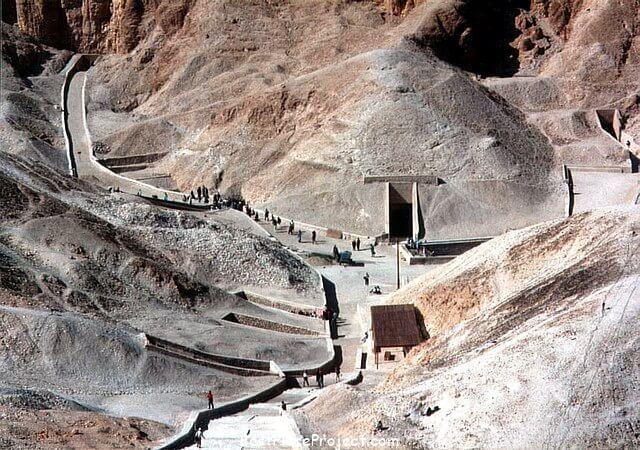
We all know about King Tut and it is here that you can visit his tomb. In fact, you can visit all of the Kings of the Pharaoh’s tombs. Ramses, I-V, and everyone in between was entombed in extravagant tombs filled with riches and jewels on the West Bank of the Nile.
You won’t see the treasures in these tombs today, but you will see the paintings and hieroglyphics drawn on the walls of these massive chambers that are as big as a house.
The tombs are impressive but the valley itself is even more incredible. I can see why the ancient Egyptians chose this as the resting place of their most important leaders.
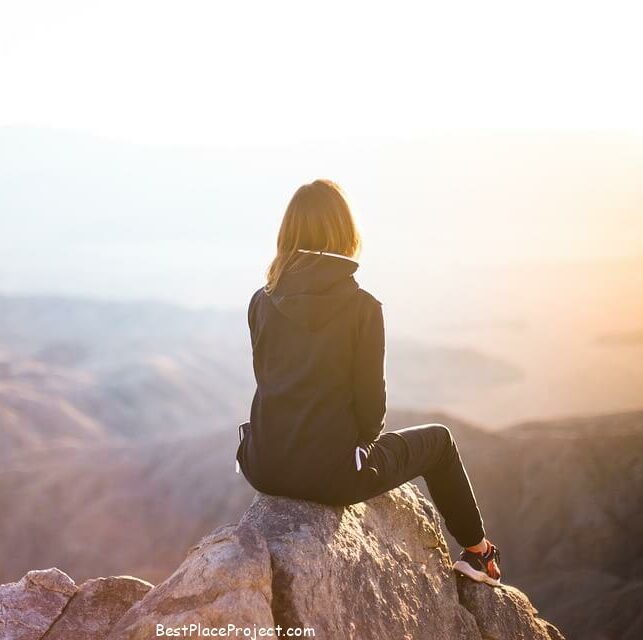
I love traveling and exploring new places and this website is all about listing all best places in the world that you can go and explore.
